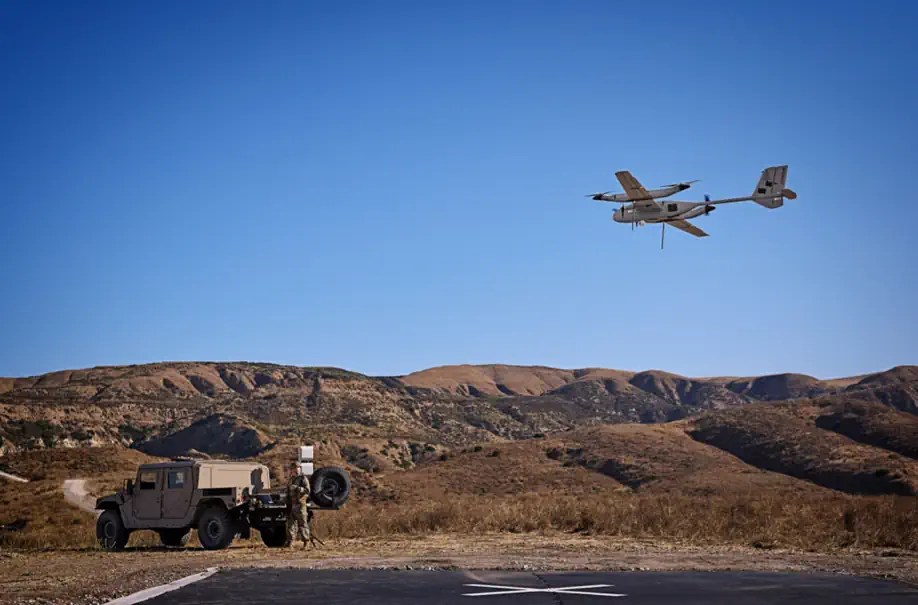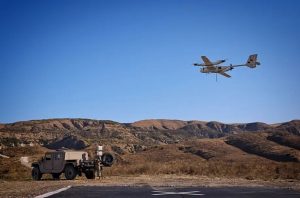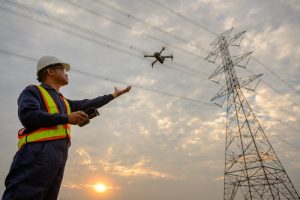AeroVironment’s P550: New Era in Autonomous Military Drones
AeroVironment (AV) has set a new standard in military drone technology with the delivery of its first P550 Autonomous Group 2 eVTOL Unmanned Aircraft Systems (UAS) to the U.S. Army for their Long-Range Reconnaissance (LRR) program. This state-of-the-art platform offers advanced battlefield adaptability, using a combination of sophisticated technology, modularity, and operational strength.
What Sets the P550 Apart?
Advanced Capabilities
- eVTOL Design: This electric Vertical Takeoff and Landing (eVTOL) drone can function in confined spaces without conventional runways, expanding deployment choices.
- Group 2 Classification: Weighing a maximum of 55 pounds, the P550 is categorized as a Group 2 UAS, ideal for military needs where balance between size, endurance, and payload is crucial.
- Endurance and Payload: It runs up to 5 hours on battery, carrying payloads up to 15 pounds, suitable for extended reconnaissance missions.
Modular Open Systems Approach (MOSA)
- Design Adaptability: Featuring a Modular Open Systems Approach, the P550 allows rapid in-field reconfiguration—achievable in less than five minutes without tools.
- AI Autonomy: Leveraging advanced AI for autonomous navigation and mission execution, the system reduces operator workload and boosts safety.
Battlefield-Ready Benefits
- Quick Deployment: Built for rapid assembly and launch, the P550 proves essential for units needing intelligence and adaptability rapidly.
- Enhanced Situational Awareness: Equipped with multi-sensor arrays, it provides precise targeting, real-time surveillance, and critical intelligence for decision-making and protection.
- Increased Security: The drone features secure communications and resistance to electronic countermeasures, maintaining operation in contested spaces.
Understanding the LRR Program
The Army’s Vision for Modern Reconnaissance
The Long-Range Reconnaissance (LRR) program strives to equip units with a drone weighing under 55 pounds, covering 30–60 km, and boasting 5–8 hours of flight endurance. The P550 aligns seamlessly with these goals, offering flexible configurations and extended operation periods.
Critical Applications
- Tactical Reconnaissance: Provides real-time sensor data crucial for command units when stealth and agility are critical.
- Target Acquisition & Protection: By integrating targeting pods and threat detection systems, it aids in identifying enemy positions while safeguarding ground troops.
- Operational Flexibility: With significant endurance and autonomy, suitable for operating in airspace with electronic conflicts and changing scenarios.
Seamless Integration and Training
AeroVironment’s delivery included comprehensive training, with a “Train-the-Trainer” program instructing Army trainers for broader skills dissemination, ensuring readiness in multiple units. Additionally, AV’s technical representatives provide ongoing integration and support.
Future-Proof Design
- Scalable Architecture: Built on an open architecture, supporting future innovations in payloads, sensors, and mission planning.
- Ongoing Upgrades: Its modular nature allows integration of advancements, such as new batteries or AI algorithms, without costly overhauls.
AeroVironment’s Reputation
Famed for its scalable UAS lineup like Raven, Puma, and Switchblade, AeroVironment continues to advance technologically, with the P550 ushering in a new era of unmanned systems.
Expert Perspectives
“Operators today need systems that adapt to dynamic combat scenarios, with unparalleled reliability,” notes Trace Stevenson, AV’s President of Autonomous Systems.
Comparison with Other LRR Competitors
| Feature | P550 (AV) | Stalker (Redwire) |
|---|---|---|
| Max Takeoff Weight | 55 lbs | Under 55 lbs |
| Endurance | Up to 5 hours | 5–8 hours |
| Payload Capacity | 15 lbs | Modular (not specified) |
| Deployment Speed | <5 minutes | Fast, not specified |
| Modularity | Toolless, MOSA | Modular |
| Autonomy Level | AI-driven | Autonomous mobility |
Implications for Modern Warfare
- Enhanced Capability: The P550 offers operational capacities traditionally requiring larger systems.
- Agility: Its rapid deployment and adaptability ensure survivability and success within shifting conditions.
- Long-Term Relevance: The modular nature lowers long-term costs while ensuring strategic technological advantages.
Looking Ahead
AeroVironment continues executing additional orders, ensuring further training as the Army deploys the P550 more widely. Continuous operational feedback will guide its future enhancements.
Conclusion
- Revolutionary Army Reconnaissance: The P550 blends advanced autonomy and rapid adaptability.
- End-to-End Solution: AeroVironment provides comprehensive support alongside the drone systems.
- Future-Proof Platform: Built on MOSA principles, it remains prepared to meet future needs.
The P550 marks a key advancement in the evolution of modular, intelligent, and responsive unmanned systems within the digital theater of war.













